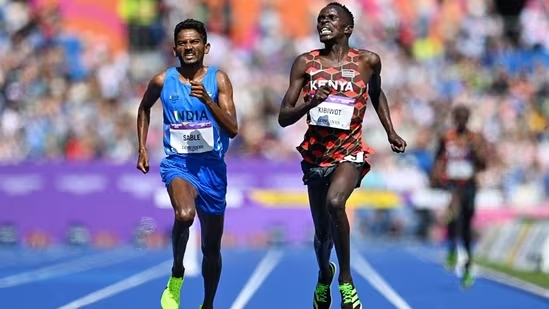Birmingham 2022 will become the mirror held up to Indian athletics
After every Commonwealth Games in this millennium, India has felt this way - buzzed from 50+ medals, awash in a flood of feel-good, enveloped in the optimistic belief that we are on our way to widespread Olympic success. This lasts a few months before the great Indian public turns its attention away from Olympic sport and two years later, resumes its quadrennial self-flagellation over an ‘only’ number of Olympic medals. (Compared to Cuba. Or Brazil. Or Kenya. Wearenotasportingnation)  PREMIUM
PREMIUM
Yet CWG Birmingham2022 will remain wonderful, for the results it threw up, for its scenes, and its surprises. Like the hockey women tunelessly screaming ‘Honge Hindustani’ from the chorus of a Bollywood song or Saurav Ghosal weeping after winning their bronze medals. Or Mirabai Chanu and Ravi Dahiya’s utter composure in their so-far-ahead-of-the-rest performances. But to reflect objectively on Birmingham2002, it’s important to go down the roads less travelled. Like in Delhi 2010 when India won their first gymnastics medals with Ashish Kumar which was followed by Dipa Karmakar’s Produnova vault in Glasgow 2014 which took her to the Rio vault final. Even though no medal in any sport is ever won without sweat, it’s important to look harder at the ‘what happens next?’ storylines, rather than ‘got that covered’ territory.
In Birmingham, India showed off its CWG muscle in wrestling, weightlifting, badminton, table tennis and boxing, the five sports winning 19 of India’s 22 golds. India’s Birmingham medals came from 12 disciplines as compared to GoldCoast 2018’s nine, also a good sign. India’s most significant performances in Birmingham2022 however came from the road less travelled through the most central of Olympic disciplines: athletics.
Given its rarity and its unbridled ambition, Avinash Sable’s silver in the 3000m steeplechase must become in contextual terms, pure gold. Only two other individual athletes have won CWG track medals – Milkha Singh’s 440yards gold in Cardiff 1958 and Kavita Raut’s 10000m bronze in Delhi 2010. There have been stunning relay performances in Manchester2006 and Delhi2010 but relay teams are easy to dismantle and somehow blur from the memory, which is what has sadly happened over the last 15 years. Sable’s silver though will not easily be diminished. It can only be bettered.
What made that medal exceptional was its most unquantifiable element. Yes, Sable busted the 18-year-old Kenyan stranglehold on the steeplechase, yes, he broke his own national record for the gazillionth time. But what will scorch itself in the mind of every young Indian middle-distance runner alive today and every middle-distance runner who will follow was Sable’s naked desire. To want more, to break down the door, turn the world upside down, to refuse to settle. On the final straight, yards ahead of the man behind him, Sable chased down Abraham Kibiwot to the line, the Kenyan eating air to hold his rival off at the finish. The man behind Sable, world u21 champ Amos Serem was to say later, in respect that Sable “was very invested in the last 300m.” It is what Sable’s successors must imitate - remaining committed, greedy, invested all the way to the end, over every hurdle and water jump they come across in their careers. Which they surely will.
Birmingham became a breakthrough for Indian athletics, not because of the result of our improved competition or performance structures but rather a handful of athletes stretching the boundaries of their ability. With a degree of streamlining of training expertise and competition access with several other entities involved in the mix. If the emergence of a singular athlete like Sable can change the conversation around Indian athletics, Sable and a group of feisty jumpers together could well be rocket fuel. India’s track and field medallists and finalists from CWG2022 are both targets and benchmarks.
In an interview with Sportstar before the world championships, Sable talked of breaking Gopal Saini’s 37-year-old steeplechase record, “Thirty years ago we were close to the world level, you had athletes who were coming fourth in the Olympics but we fell behind. If a record lasts for 30 years, it’s not good. If a top athlete is strong, it changes the mindset of others behind him.” He talked of how Chopra’s Tokyo gold was going to produce more 80m+ throwers in India. Birmingham2022 has proven that it is never too late to set off a domino effect across Indian athletics.
But it will have to take place with an undercurrent of the establishment response which must not ignored. In the equation between official and athlete, at the moment, the establishment still believes they have the upper hand. Power is exercised through participation tickets, evident in the selection snafus that preceded the world athletics championships and Birmingham 2022. The selection process is opaque, usually meant to teach athletes a lesson or keep them in line.
It should be of no surprise to anyone that one of the Birmingham2022 medallists, once found himself standing outside an airport, boarding pass in hand, being threatened over the phone. And being told that if he got on that plane, he would never compete for India again - because he had not followed due process with adequate genuflection to fragile athletic establishment ego in Patiala over seeking permission to travel.
Nothing frightens Indian sports officials more than the athletes becoming bigger than them, freed off the shackles, and to mix another metaphor, even off their leash. Except now, Neeraj Chopra has done it in real terms and Sable has showed he belongs on the big stage and Murali Sreeshankar has turned up at the Diamond League and Tejaswin Shankar did not hesitate to take them to court.
In the future, Birmingham 2022 will hold up the mirror to Indian athletics, for both its officialdom and its participants. About what they do and how far they are willing to go from here.
Experience unrestricted digital access with HT Premium
Explore amazing offers on HT + Economist Start 14 Days Free Trial Already Subscribed? Sign In
Disclaimer: The copyright of this article belongs to the original author. Reposting this article is solely for the purpose of information dissemination and does not constitute any investment advice. If there is any infringement, please contact us immediately. We will make corrections or deletions as necessary. Thank you.







